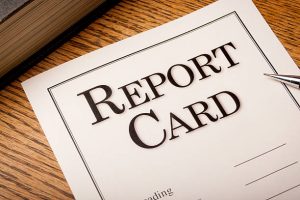
It has been said that the stormwater sector is the “new kid on the block” in the water world, but on Tuesday, August 29, 2017, stormwater took another step towards “growing up”. Dominique Lueckenhoff, Acting Director of the Water Protection Division for EPA Region III (Mid-Atlantic), keynoted the StormCON 2017 opening general session, and included as part of her talk a live poll to raise the awareness of the fact that the stormwater sector does not have a “report card” as other infrastructure sectors do, including drinking water, wastewater, and water resources infrastructures.
The reason for putting stormwater on the map with other infrastructure, as Ms. Lueckenhoff stressed in her talk, is due to the many social and environment benefits associated with investments in stormwater infrastructure (in particular green stormwater infrastructure). These benefits include reduced urban heat island impacts, replenishment of groundwater resources, increased flood resilience, and enhanced economic development. These last two benefits (resilience and economic development) are particularly valuable to communities. As Houston is reminding us right now, the need for increased resilience to combat flooding in the face of major episodic storms is critical to the stability of our urban areas. In other areas, we see green infrastructure being used to renew blighted urban areas and drive jobs and small businesses to benefit the local and regional economy. The bottom line here is that investments in stormwater can pay back in significant ways.
Ms. Lueckenhoff also focused on the ability for emerging technologies in the stormwater sector can enhance investments overall. By using real-time controls to optimize BMP performance, the unused treatment capacity associated with standard BMPs is reduced or eliminated. Monitoring of stormwater practices through remote, cloud-based platforms allows for continuous reporting of performance that can be used to provide as-needed maintenance support for BMPs, thereby reducing O&M costs overall. Considering BMPs as a system that exists within a watershed, while employing dynamic flow control systems can provide outcomes that optimize the performance throughout the catchment, as opposed to considering BMPs in isolation. And there is a movement now to apply the “open source” paradigm to the stormwater sector as the field becomes more and more “big data” oriented. Beyond automation, technologies that enhance the physical performance of stormwater practices are being utilized to better meet the demands of siting BMPs in challenging areas. One example are high-flow media, which can infiltrate runoff at extremely fast rates, thereby reducing the footprint of infiltration-based practices by an order of magnitude ore more. All of these technologies fall into the category of “smart” stormwater technologies, and it is expected that these and other advancements will continue to push the envelope of BMP performance at various scales.
But being smart in the stormwater sector goes beyond simply applying new technologies. Ms. Lueckenhoff shared information on new ways in which cities and towns are considering non-traditional financing approaches as well as alternative project delivery methods to increase overall investments in integrated green infrastructure. A specific framework to drive down capital and O&M costs, increase the pace of project delivery, and ensure that local jobs are generated and businesses supported is the Community-Based Public-Private Partnership (CBP3) program approach. This framework is currently employed by two communities on the East Coast and being considered by several others around the country. The premise of this approach is to for public and private parties to create a new entity – a CBP3 entity – that includes the interests of both the public and the private entities – whose mission is to meet goals defined by the community that range from BMP implementation and maintenance cost reductions to local jobs created. This type of program aims at large investments in green infrastructure, and it is these types of investments that can more effectively harness the co-benefits of green infrastructure.
Near the beginning of the talk, Ms. Lueckenhoff asked the 1000 or so audience members to give grades for eight different criteria, all consistent with the ASCE Infrastructure Report Card, that include funding, maintenance, current condition, resilience provided, and innovation in the sector. Approximately 200 respondents provided input and gave a wide range of grades, but there were clear results – and they reflect a sector that is in bad shape, like much of the other infrastructure sectors in the U.S., as the overall grade was found to be a “D”. She then shared information on “smart” approaches to stormwater management, and invited audience members to go online and vote for grades focused on the stormwater sector for both current and for “smart” conditions (i.e., stormwater sector as it currently is vs. what the stormwater sector could be with widespread adoption of “smart” approaches). Regardless of the results, the bigger point was for stormwater to be treated like other infrastructure sectors and to have a voice at the table for the conversation regarding the need for investment in infrastructure now and in the future.
For full results, please see the following link. To vote yourself, go to the following link for current conditions and then go to this link to give grades for “smart” stormwater conditions.



